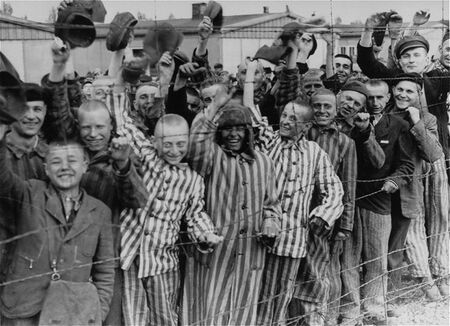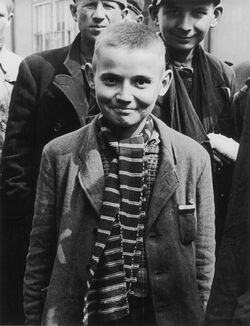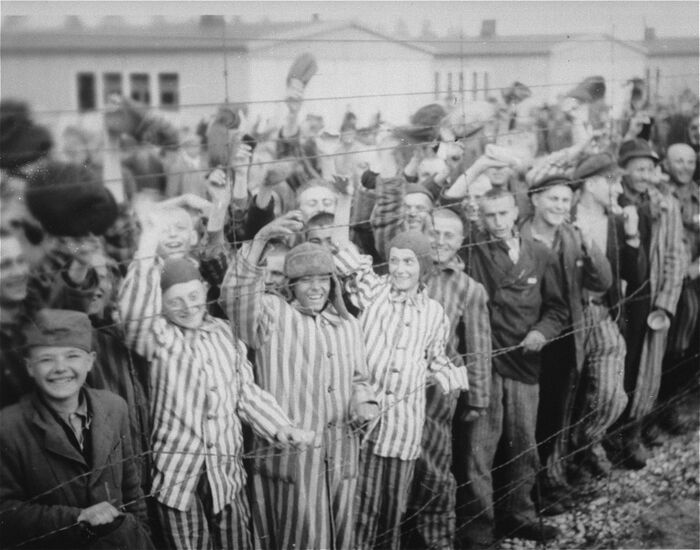Category:Liberation of Dachau (subject)
Liberation of Dachau
- See Dachau Database
- Young and old survivors in Dachau cheer arriving U.S. troops. In the middle stands 18 yr. old Juda Kukiela, the son of Mordcha Mendel and Ruchla Ita. Second from the left is Gyorgy Laszlo Spiegel (b. 5/25/30) from Budapest, Hungary.
==
- Alex Rosner (Aleksander Rossner
Newsday
Alex Rosner's red accordion sat in a plastic bag in his basement for decades.
Rosner, 79, of Long Island City, decided a few months ago to donate his last possession from his time as a prisoner of the Germans during World War II to the Holocaust Memorial and Tolerance Center of Nassau County in Glen Cove.
A female Nazi guard gave him the accordion when he was at the Auschwitz-Birkenau concentration camp in Poland.
"He's representing all those who didn't survive through his story, through his accordion," said Steven Markowitz, his friend and the center's chairman. "It brings the reality of the Holocaust to life."
The facility currently has an exhibit of items donated by survivors, their families and others. The objects include a soft leather shoe left by a child at Auschwitz; a beer stein decorated with anti-Semitic caricatures; and a lightbulb, all that remains of a synagogue in Greece. The exhibit runs until April 30.
"It's only by bringing these stories to light, by telling the stories and using actual artifacts from that time, to prove that it happened," Markowitz said.
In about 1940, Nazis took Rosner, then 5, from his home in Poland, along with his parents, Henry and Marianne, all Jews. They first lived in a crowded ghetto in Krakow and then the Plaszow concentration camp outside of the city.
Rosner and his father were later transferred to Oskar Schindler's factory at Plaszow. Rosner's mother arrived weeks later, after he and his father were taken to Auschwitz. Schindler's story of how he saved about 1,200 Jews was told in the movie "Schindler's List."
"We were all on line to the gas chamber, when someone recognized my father and told the person in charge that he was a violinist," Alex Rosner said.
Rosner said his father told the Nazis he would only play for the camps' commandants if his son lived.
The younger Rosner said a female Nazi guard asked him if he played any instruments. He told her the accordion, and she came back with the instrument now on display in Glen Cove. He said he played it a few times and accompanied his father once.
His father's violin and the accordion were confiscated when father and son were taken to Dachau concentration camp in Germany, where they were liberated by American soldiers in May 1945.
They were reunited with Marianne Rosner in Munich, Germany. Schindler had found both instruments and gave them to her, which she brought with her, Rosner said.
"She thought we were dead," he said. "She had reports that people saw us being killed."
The reunited family moved to the United States in the summer of 1946. They moved into an apartment in Astoria. After a year in a public school, Rosner said, he "went on as a normal kid and no one suspected that I was any different than they were. I made a conscious decision to turn my back on the past . . . but it was fair to say that I wasn't firing on all cylinders because I hated everyone but the United States and my parents."
Rosner attended Rensselaer Polytechnic Institute in Troy, served in the United States Naval Reserve, is married, has three grown children and built the sound engineering business he still runs in Astoria.
He started speaking about his life as a Holocaust survivor about two decades ago.
"It is still difficult to do, but I manage," he said. "As long as the interest in the Holocaust continues, as a witness, I am willing to speak."
Pages in category "Liberation of Dachau (subject)"
The following 17 pages are in this category, out of 17 total.
1
- Lucien Ambrosiewicz (M / Poland, 1927-2017), Holocaust survivor
- Sandor Braun
- Yosef Kleinman
- Simcha Frumkin / Simon Frumkin (M / Lithuania, 1930), Holocaust survivor
- Gregor Griliches / Zvi Griliches (M / Lithuania, 1930-1999), Holocaust survivor
- Pawel Hodys
- Roman Lubetzky
- Gyorgy Laszlo Spiegel / Georg Spiegel (M / Hungary, 1930), Holocaust survivor
- Steve Ross / Szmulek Rozental (M / Poland, 1931-2020), Holocaust survivor
- Alex Rosner (M / Poland, 1935), Holocaust survivor
- Jossi Grün (M / Hungary, 1945), Holocaust survivor
- Judith Kálmán (F / Hungary, 1945), Holocaust survivor
- Hana Klein / Szuzi Löwy (F / Hungary, 1945), Holocaust survivor
- Agnes Kovács (F / Hungary, 1945), Holocaust survivor
- Gyuri Legmann / George Legmann (M / Hungary, 1945), Holocaust survivor
- Marika Novakova / Maria Novakova (F / Hungary, 1945), Holocaust survivor
- Leslie Rosenthal (M / Hungary, 1945), Holocaust survivor
Media in category "Liberation of Dachau (subject)"
This category contains only the following file.
- 2018 Ross.jpg 334 × 499; 20 KB



